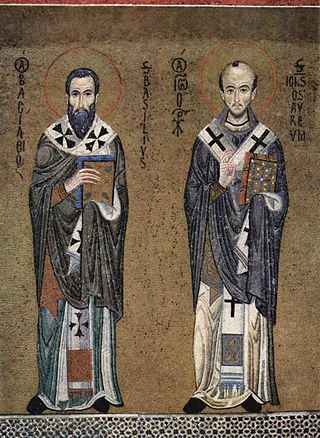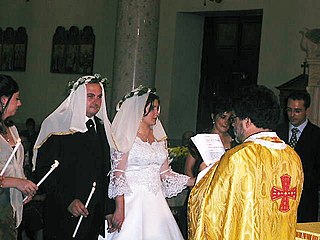
All Souls' Day, also called The Commemoration of All the Faithful Departed, is a day of prayer and remembrance for the faithful departed, observed by Christians on 2 November. Through prayer, intercessions, alms and visits to cemeteries, people commemorate the poor souls in purgatory and gain them indulgences.

Quinquagesima, in the Western Christian Churches, is the last pre-Lenten Sunday, being the Sunday before Ash Wednesday, and the first day of Carnival. It is also called Quinquagesima Sunday, Quinquagesimae, Estomihi, Shrove Sunday, Pork Sunday, or the Sunday next before Lent.

Great Lent, or the Great Fast, is the most important fasting season of the church year within many denominations of Eastern Christianity. It is intended to prepare Christians for the greatest feast of the church year, Pascha (Easter).

The liturgical year, also called the church year, Christian year or kalendar, consists of the cycle of liturgical days and seasons that determines when feast days, including celebrations of saints, are to be observed, and which portions of scripture are to be read.

Divine Liturgy or Holy Liturgy is the usual name used in most Eastern Christian rites for the Eucharistic service.

In the practice of Christianity, canonical hours mark the divisions of the day in terms of fixed times of prayer at regular intervals. A book of hours, chiefly a breviary, normally contains a version of, or selection from, such prayers.

Septuagesima is the name for the ninth Sunday before Easter, the third before Ash Wednesday. The term is sometimes applied to the seventy days starting on Septuagesima Sunday and ending on the Saturday after Easter. Alternatively, the term is sometimes applied also to the period sometimes called pre-Lent that begins on this day and ends on Shrove Tuesday, the day before Ash Wednesday, when Lent begins.
Alleluia is a phrase in Christianity used to give praise to God. In Christian worship, Alleluia is used as a liturgical chant in which that word is combined with verses of scripture, usually from the Psalms. This chant is commonly used before the proclamation of the Gospel. In Western Christianity, congregations commonly cease using the word Alleluia during the period of Lent but restore it into their services at Easter. The form of praise "Alleluia" is used by Christians to thank and glorify God; it finds itself present in many prayers and hymns, especially those related to Eastertide, such as "Christ the Lord is Risen Today".

Sexagesima, or, in full, Sexagesima Sunday, is the name for the second Sunday before Ash Wednesday in the pre-1970 Roman Rite liturgical calendar of the Catholic Church, and also in that of some Protestant denominations, particularly those with Lutheran and Anglican origins. Sexagesima falls within pre-Lent.
Christian liturgy is a pattern for worship used by a Christian congregation or denomination on a regular basis. The term liturgy comes from Greek and means "public work". Within Christianity, liturgies descending from the same region, denomination, or culture are described as ritual families.

The Anaphora, Eucharistic Prayer, or Great Thanksgiving is a portion of the Christian liturgy of the Eucharist in which, through a prayer of thanksgiving, the elements of bread and wine are consecrated. The prevalent historical Roman Rite from is called the "Canon of the Mass."

The Epiphany season, also known as Epiphanytide or the time of Sundays after Epiphany, is a liturgical period, celebrated by many Christian Churches, which immediately follows the Christmas season. It begins on Epiphany Day, and ends at various points as defined by those denominations. The typical liturgical color for the day of Epiphany is white, and the typical color for Epiphany season is green.

Pre-Lent begins the Christian time of preparation for Easter, in the three weeks before Lent. This period launches a campaign of catechesis, reflected in the liturgical readings. Its best-known feature is its concluding three-day festival, Carnival or Shrovetide.
Quadragesima Sunday is the first Sunday in Lent, occurring after Ash Wednesday.

The East Syriac Rite, or East Syrian Rite, is an Eastern Christian liturgical rite that employs the Divine Liturgy of Saints Addai and Mari and utilizes the East Syriac dialect as its liturgical language. It is one of the two main liturgical rites of Syriac Christianity, along with the West Syriac Rite.

Youakim Moubarac was a Lebanese French scholar. He was an Islamologist, an Arabist and a disciple of the Orientalist Louis Massignon and of philosopher Louis Gardet. A Maronite priest, Moubarac dedicated his life and major works to interfaith dialogue between Christianity and Islam, to Arab and Lebanese causes, to the unity of the Church and to the Maronite Church Antiochian heritage.

Istifan al-Duwayhi or Estephan El Douaihy was the 57th Patriarch of the Maronite Church, serving from 1670 until his death. He was born in Ehden, Lebanon.
The Season of Annunciation or Season of Announcements, is a liturgical season in Syriac Christianity. The name of the season is in reference to the Annunciation to the Blessed Virgin Mary, the announcement by the Archangel Gabriel to the Blessed Virgin Mary, that she would conceive and bear a son through a virgin birth and become the mother of Jesus Christ.

The Holy Qurobo or Holy Qurbono refers to the Eucharist as celebrated in Syro-Antiochene Rite and the liturgical books containing rubrics for its celebration. West Syriac Rite includes various descendants of the Oriental Orthodox and Eastern Catholic churches. It consists of two distinct liturgical traditions: the Maronite Rite, and the Jacobite Rite. The major Anaphora of both the traditions is the Divine Liturgy of Saint James in Syriac language. The Churches are primarily based in the Middle East, Africa, and India.

The Mystery of Crowning is a ritual component of the sacrament of marriage in Eastern Christianity. Variations of the crowning ceremony exist in multiple liturgical rites, including the Byzantine, Coptic, West Syriac, and East Syriac Rites of the Eastern Orthodox, Oriental Orthodox, and Eastern Catholic Churches. The crowning ceremony typically features a crown being placed upon the head of both the bride and bridegroom, crowning them as the queen and king of a new family.















